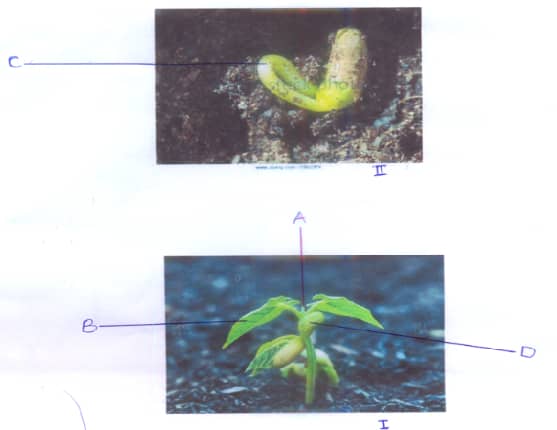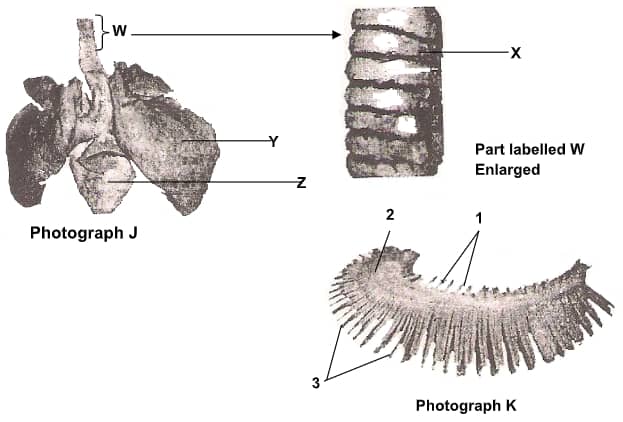INSTRUCTIONS TO CANDIDATES
- This paper consists of three questions
- Answer all the questions in the spaces provided.
- You are required to spend the first 15 minutes of the 1¾Hours allowed for this paper reading through all the questions before commencing your work.
- You are provided with solution W in a boiling tube. Using the provided reagents, carry out possible food tests to identify food substances present in solution. (14marks)
FOOD SUBSTANCE PROCEDURE OBSERVATION CONCLUSION - Examine the photographs I and II of seedling specimen shown below and answer the questions that follows;

- Name the parts labelled A, C and D. (3 marks)
-
- Name the class to which the specimen belongs. (l mark)
- Give two reasons, using observable features to support your answer in (b) (i) above (2 marks)
- Give two functions of the structure labeled D. (2 marks)
- Explain how the curvature labeled C is formed (3marks)
- Name the type of germination exhibited by the seedlings. Give a reason for your answer. (2marks)
- Below are photographs labelled J and K of organs obtained from different animals. The organs perform similar functions. Examine them.

- Name the phylum to which the organs were obtained from (1 mark)
- Identify the organs. (2 marks)
J___________________________________________________
K___________________________________________________ - State the function performed by the organs. (1 mark)
- Name the parts labelled X, Y and Z in photograph J (3 marks)
- Identify the parts labelled 1, 2 and 3 in photograph K. (3 marks)
- Using observable features, state how the parts labelled 1 to 3 you identified in (d) above are adapted to their functions (3 marks)
CONFIDENTIAL
Each candidate should be supplied with the following
- 4 test tubes in test tube rack.
- 1 boiling tube
- Iodine solution – supplied with a dropper
- Adequate distilled water
- Benedict solution– supplied with a dropper
- Means of heating
- 10% Sodium Hydroxide– supplied with a dropper
- 1% Copper (II) Sulphate– supplied with a dropper
- DCPIP– supplied with a dropper
- 10cm3 of solution W in a boiling tube labeled as solution W
NB: measure 30gms of glucose and 15gms of egg albumen in a 500ml beaker, add 200cm3 of distilled water and stir to dissolve. Top up with distilled water to make 500cm3 solution. Label this solution as solution W

MARKING SCHEME
-
FOOD SUBSTANCE PROCEDURE OBSERVATION CONCLUSION Starch To solution W add (2drops of)iodine solution Brown/ yellow colour persist/remains
Rej. No colour change observedStarch absent Reducing sugars To solution W, add Benedict’s solution and heat to boil
Colour changes from blue to green to yellow to orange
Acc. Final colour.
Rej: red colourReducing sugars present Ascorbic acid/ vitamin C To DCPIP, add the food solution dropwise, while shaking. Blue color of the DCPIP retain/remain Ascorbic Acid absent Proteins To solution W add sodium hydroxide then copper (II) sulphate
Rej: heatBlue color of copper (II) sulphate changes to purple proteins present -
- A – plumule;
C – Hypocotyl;
D – Cotyledon/ seed leaf; -
- Dicotyledonae;
-
- Presence of two cotyledons;
- Network venation;
-
- Storage of food;
- Formation of the first seed leaf;
-
- Auxins diffuse on the lower side of the root (due to gravity) in the root high concentration of auxin inhibits growth of the root, while low concentration promotes growth the root;
- Less auxins concentration on the upper side causes faster cell elongation than on lower side hence the formation of the curvature; (Max. 3)
- Type – Epigeal germination;
Reason – cotyledons emerges above the ground;
- A – plumule;
-
- Phylum chordata
- J – Lungs
K – Gills - Gaseous exchange / external respiration
- X – Ring of cartilage
Y – Lung
Z – Heart -
- Gill rakers
- Gill arch / bar
- Gill filaments
-
- Rake like / projections for trapping solid particles
- Toothlike/ needle like projections for trapping / sieving / filtering solid particles from damaging the filaments
- Many / numerous/ long filaments to increase surface area for gaseous exchange
Download Biology Paper 3 Questions and Answers with Confidential - Bungoma Diocese Mock Exams 2021/2022.
Tap Here to Download for 50/-
Get on WhatsApp for 50/-
Why download?
- ✔ To read offline at any time.
- ✔ To Print at your convenience
- ✔ Share Easily with Friends / Students

